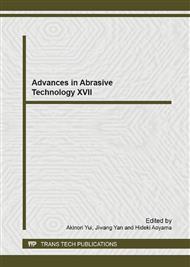p.218
p.222
p.228
p.237
p.243
p.249
p.255
p.261
p.267
High Efficiency Abrasive Waterjet Dressing of Diamond Grinding Wheel
Abstract:
A grinding wheel wears rapidly during ultrasonic assisted surface generation of a large aperture aspherical RB-SiC mirror, which leads to an increase of grinding force and profile error. In this paper, different types of resinoid bonded diamond grinding wheel with a same grit size were dressed with high-pressure abrasive water jet. The dressing effects of abrasive water jet were assessed through comparing the 3D roughness of the grinding wheel topographies before and after dressing. The experimental results show that diamond grits of a worn grinding wheel are protruding from bond after dressing. The feed rate of nozzle and the bond materials have significant impact on the 3D surface roughness of the wheel and dressing efficient. The softer binder and the decrease of the feed rates and lead to deeper grooves during dressing of grinding wheel. However, too low feed rate will make a large number of abrasive particles drop from binder, which worsens the wheel topography. Therefore, to dress grinding wheel well and efficiently, optimized feed rate must be chosen.
Info:
Periodical:
Pages:
243-248
Citation:
Online since:
September 2014
Authors:
Price:
Сopyright:
© 2014 Trans Tech Publications Ltd. All Rights Reserved
Share:
Citation:


